TOYOTA YARIS SEDAN 2008 Owners Manual
Manufacturer: TOYOTA, Model Year: 2008, Model line: YARIS SEDAN, Model: TOYOTA YARIS SEDAN 2008Pages: 384, PDF Size: 6.19 MB
Page 321 of 384

5
When trouble arises
309
5-2. Steps to take in an emergency
nIf you have a flat front tire on a road covered with snow or ice
Install the compact spare tire on the rear of the vehicle. Perform the fol-
lowing steps and fit tire chains to the front tires.
Replace a rear tire with the compact spare tire.
Replace the flat front tire with the tire removed from the rear of
the vehicle.
Fit tire chains to the front tires.
Page 322 of 384

310 5-2. Steps to take in an emergency
CAUTION
nUsing the jack
Improper use of the jack may lead to death or injuries due to the vehicle
suddenly falling off the jack.
lDo not use the jack for any purpose other than replacing tires or install-
ing and removing tire chains.
lOnly use the jack that comes with this vehicle for replacing a flat tire.
Do not use it on other vehicles, an d do not use other jacks for replac-
ing tires on this vehicle.
lAlways check that the jack is securely set to the jack point.
lDo not put any part of your body under the vehicle supported by a jack.
lDo not start or run the engine while your vehicle is supported by the
jack.
lDo not raise the vehicle while someone is in it.
lWhen raising the vehicle, do not put an object on or under the jack.
lDo not raise the vehicle to a hei ght greater than that required to
replace the tire.
lUse a jack stand if it is necessary to get under the vehicle.
Take particular care when lowering the vehicle to ensure that no one
working on or near the vehicle will be injured.
nReplacing a flat tire
Observe the following precautions to reduce the risk of death or serious
injury.
lNever use oil or grease on the wheel bolts or wheel nuts.
The oil or grease can cause the wheel nuts to loosen, causing a seri-
ous accident.
Remove any oil or grease on the wheel bolts or wheel nuts.
lHave the wheel nuts tightened with a torque wrench to 76 ft·lbf (103
N·m, 10.5 kgf·m) as soon as possible after changing wheels.
Failure to follow these precautions could cause the nuts to loosen and
the wheel may fall off, which could lead to an accident causing death
or serious injury.
Page 323 of 384

5
When trouble arises
311
5-2. Steps to take in an emergency
CAUTION
nWhen using the compact spare tire
lRemember that your compact spare
tire is specifically designed for
use with your vehicle. Do not use your compact spare tire on another
vehicle.
lDo not use two compact spare tires simultaneously.
lReplace the compact spare tire with a standard tire as soon as possi-
ble.
lAvoid sudden acceleration, deceleration and braking, as well as sharp
cornering.
nSpeed limit when using the compact spare tire
Do not drive at speeds in excess of 50 mph (80 km/h) when a compact
spare tire is installed on the vehicle.
The compact spare tire is not designed for driving at high speeds. Failing
to observe this precaution may lead to an accident causing death or seri-
ous injury.
n When the spare tire is attached
The vehicle speed may not be correctly detected, and the following systems
may not operate correctly.
lABS
Page 324 of 384

312 5-2. Steps to take in an emergency
NOTICE
nDo not drive the vehicle with a flat tire.
Do not continue driving with a flat tire.
Driving even a short distance with a flat tire can damage the tire and the
wheel beyond repair.
nBe careful when driving over bumps with the compact spare tire
installed on the vehicle.
The vehicle becomes lower when driving with the compact spare tire
compared to when driving with standard tires. Be careful when driving
over uneven road surfaces.
nDriving with tire chains and the compact spare tire
Do not fit tire chains to the compact spare tire.
Tire chains may damage the vehicle body and adversely affect driving
performance.
nWhen replacing the tires
lWhen removing or fitting the wheels, tires or the tire pressure warning
valve and transmitter, contact your Toyota dealer as the tire pressure
warning valve and transmitter may be damaged if not handled cor-
rectly.
lReplace the grommets for the tire pressure warning valves and trans-
mitters as well.
nTo avoid damaging the tire pressure warning valves and transmit-
ters
Do not use liquid sealants on flat tires.
Page 325 of 384
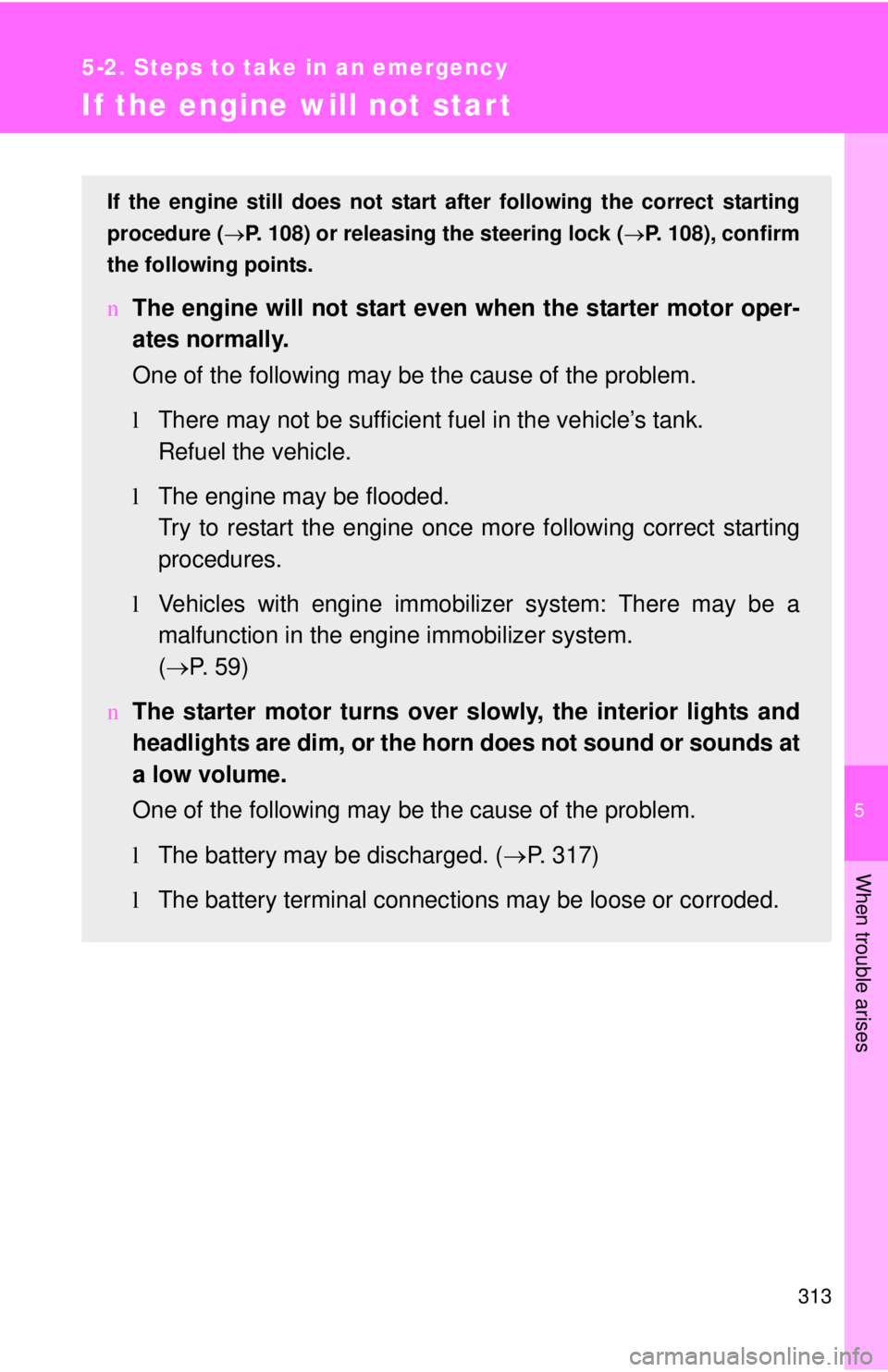
5
When trouble arises
313
5-2. Steps to take in an emergency
If the engine will not start
If the engine still does not start after following the correct starting
procedure ( →P. 108) or releasing the steering lock (→P. 108), confirm
the following points.
n The engine will not start even when the starter motor oper-
ates normally.
One of the following may be the cause of the problem.
lThere may not be sufficient fuel in the vehicle’s tank.
Refuel the vehicle.
l The engine may be flooded.
Try to restart the engine once more following correct starting
procedures.
l Vehicles with engine immobilizer system: There may be a
malfunction in the engine immobilizer system.
( → P. 5 9 )
n The starter motor turns over slowly, the interior lights and
headlights are dim, or the horn does not sound or sounds at
a low volume.
One of the following may be the cause of the problem.
lThe battery may be discharged. ( →P. 317)
l The battery terminal connec tions may be loose or corroded.
Page 326 of 384
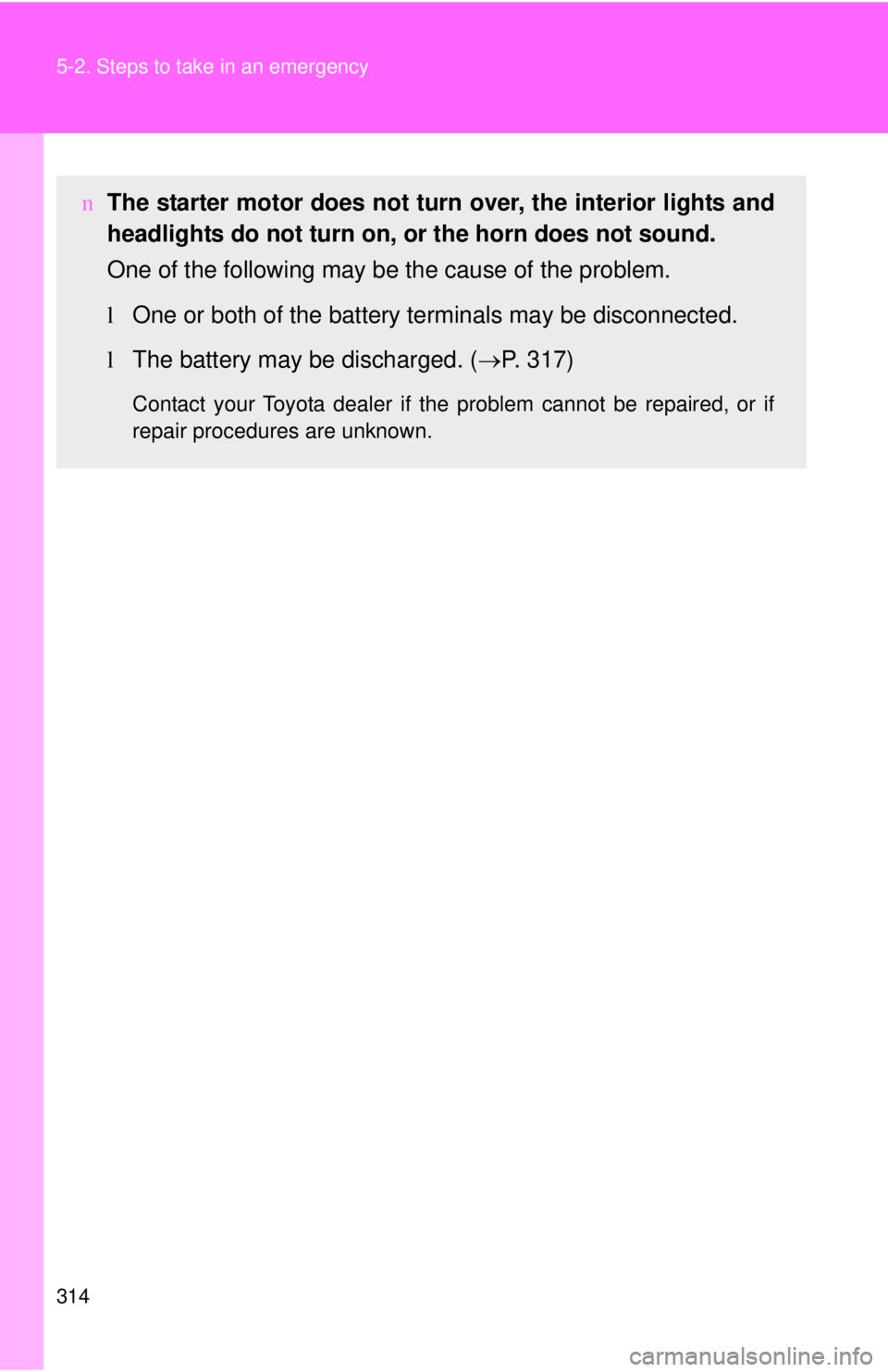
314 5-2. Steps to take in an emergency
nThe starter motor does not turn over, the interior lights and
headlights do not turn on, or the horn does not sound.
One of the following may be the cause of the problem.
l One or both of the battery terminals may be disconnected.
l The battery may be discharged. ( →P. 317)
Contact your Toyota dealer if the problem cannot be repaired, or if
repair procedures are unknown.
Page 327 of 384
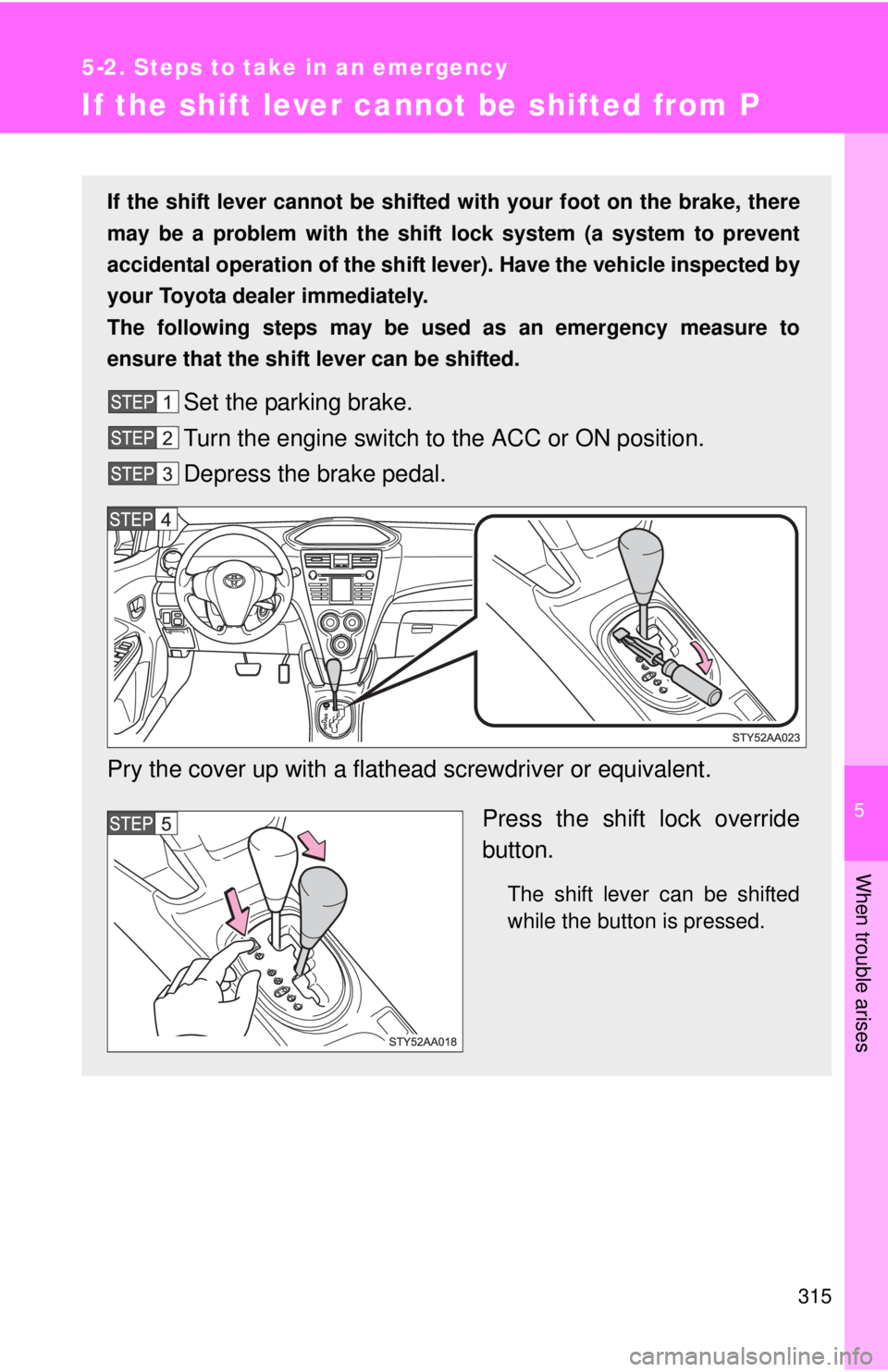
5
When trouble arises
315
5-2. Steps to take in an emergency
If the shift lever cannot be shifted from P
If the shift lever cannot be shifted with your foot on the brake, there
may be a problem with the shift lock system (a system to prevent
accidental operation of the shift lever). Have the vehicle inspected by
your Toyota dealer immediately.
The following steps may be used as an emergency measure to
ensure that the shift lever can be shifted.
Set the parking brake.
Turn the engine switch to the ACC or ON position.
Depress the brake pedal.
Pry the cover up with a flathead screwdriver or equivalent. Press the shift lock override
button.
The shift lever can be shifted
while the button is pressed.
Page 328 of 384
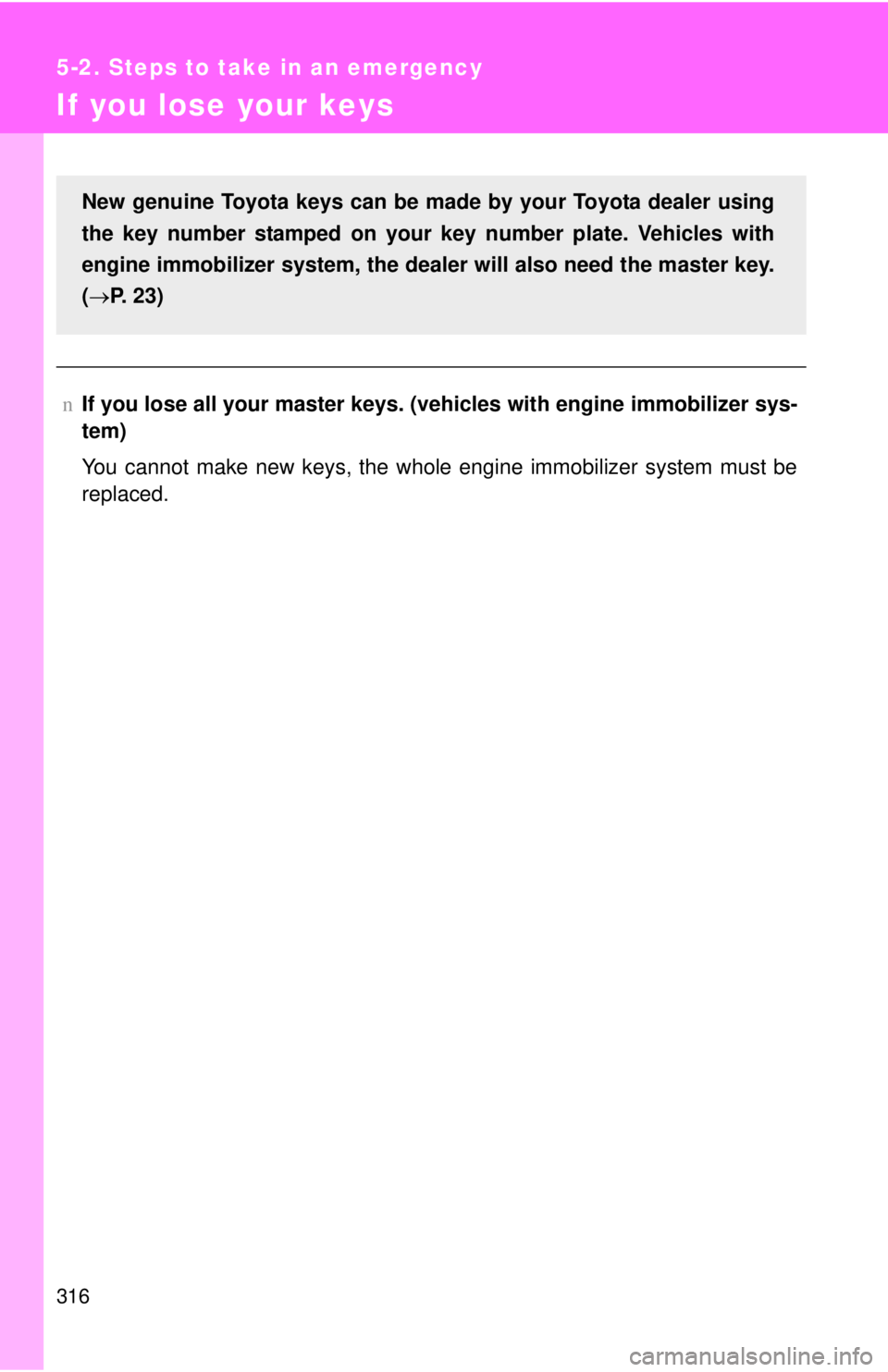
316
5-2. Steps to take in an emergency
If you lose your keys
nIf you lose all your master keys. ( vehicles with engine immobilizer sys-
tem)
You cannot make new keys, the whole engine immobilizer system must be
replaced.
New genuine Toyota keys can be made by your Toyota dealer using
the key number stamped on your key number plate. Vehicles with
engine immobilizer system, the dealer will also need the master key.
( →P. 23)
Page 329 of 384
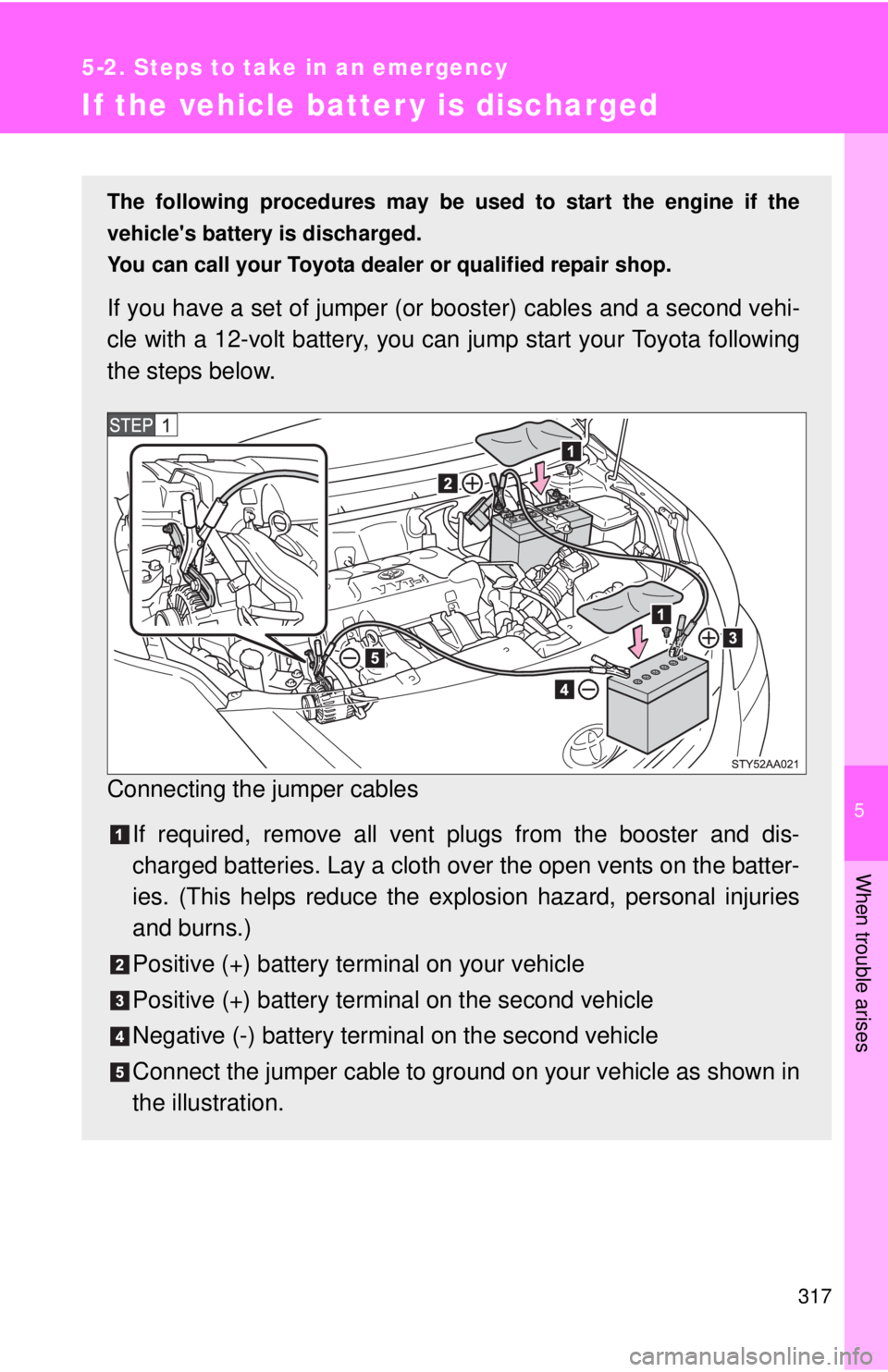
5
When trouble arises
317
5-2. Steps to take in an emergency
If the vehicle batter y is discharged
The following procedures may be used to start the engine if the
vehicle's battery is discharged.
You can call your Toyota dealer or qualified repair shop.
If you have a set of jumper (or boo ster) cables and a second vehi-
cle with a 12-volt battery, you can jump start your Toyota following
the steps below.
Connecting the jumper cables
If required, remove all vent plugs from the booster and dis-
charged batteries. Lay a cloth ov er the open vents on the batter-
ies. (This helps reduce the explosion hazard, personal injuries
and burns.)
Positive (+) battery terminal on your vehicle
Positive (+) battery terminal on the second vehicle
Negative (-) battery terminal on the second vehicle
Connect the jumper cable to ground on your vehicle as shown in
the illustration.
Page 330 of 384
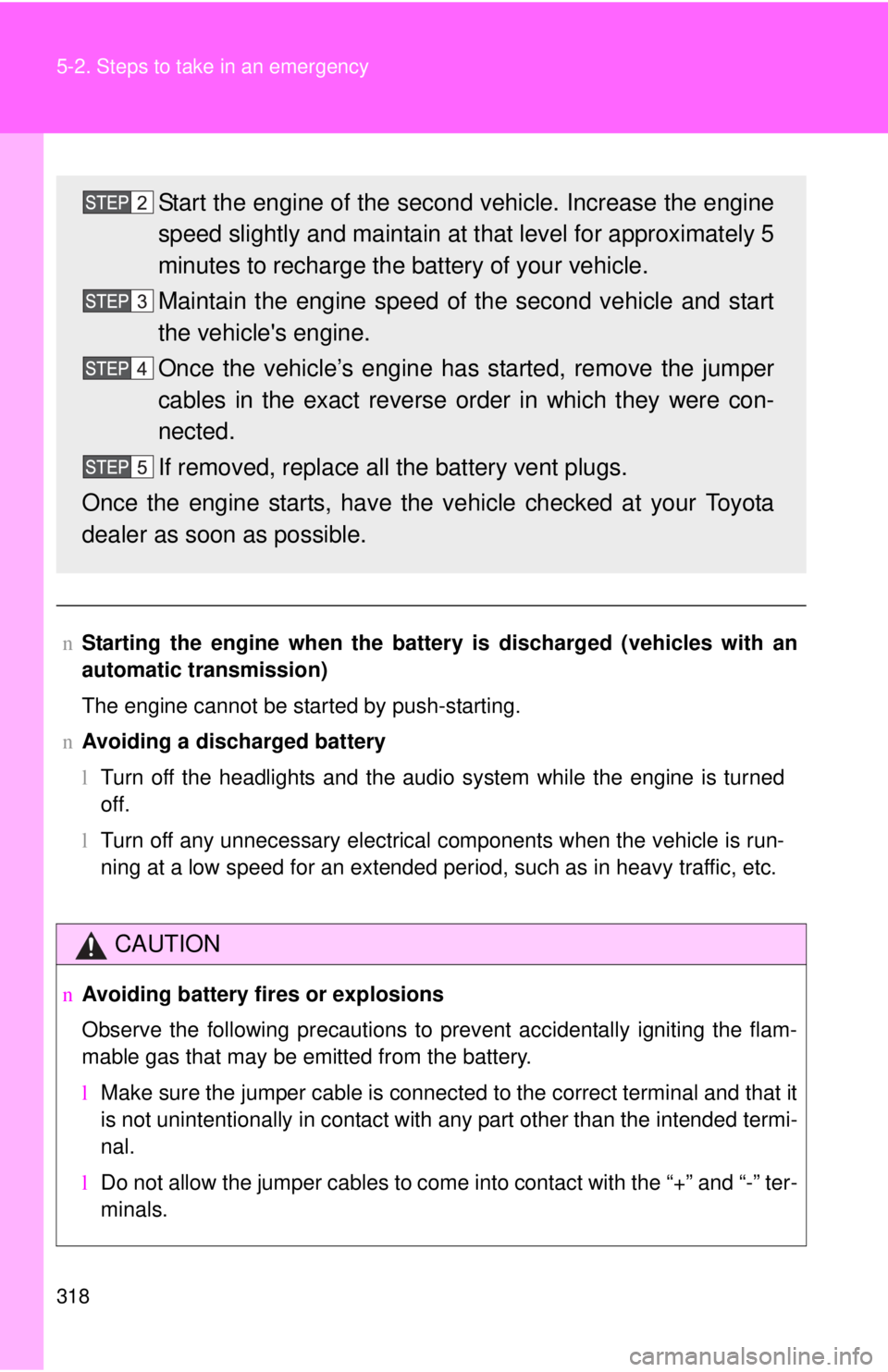
318 5-2. Steps to take in an emergency
nStarting the engine when the battery is discharged (vehicles with an
automatic transmission)
The engine cannot be started by push-starting.
n Avoiding a discharged battery
lTurn off the headlights and the audio system while the engine is turned
off.
l Turn off any unnecessary electrical components when the vehicle is run-
ning at a low speed for an extended period, such as in heavy traffic, etc.
CAUTION
nAvoiding battery fires or explosions
Observe the following precautions to prevent accidentally igniting the flam-
mable gas that may be emitted from the battery.
lMake sure the jumper cable is connected to the correct terminal and that it
is not unintentionally in contact with any part other than the intended termi-
nal.
l Do not allow the jumper cables to come into contact with the “+” and “-” ter-
minals.
Start the engine of the second vehicle. Increase the engine
speed slightly and maintain at that level for approximately 5
minutes to recharge the battery of your vehicle.
Maintain the engine speed of the second vehicle and start
the vehicle's engine.
Once the vehicle’s engine has started, remove the jumper
cables in the exact reverse order in which they were con-
nected.
If removed, replace all the battery vent plugs.
Once the engine starts, have the vehicle checked at your Toyota
dealer as soon as possible.